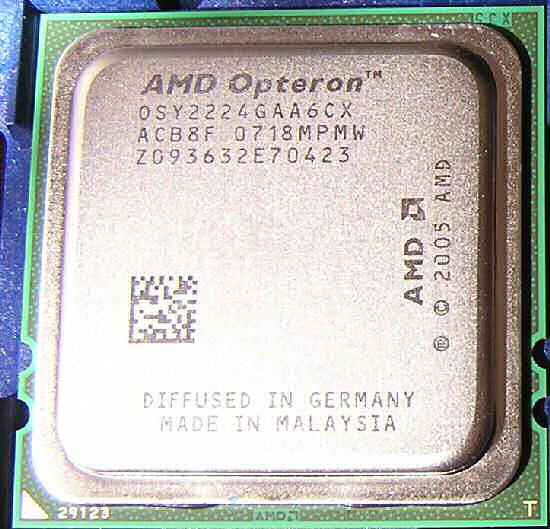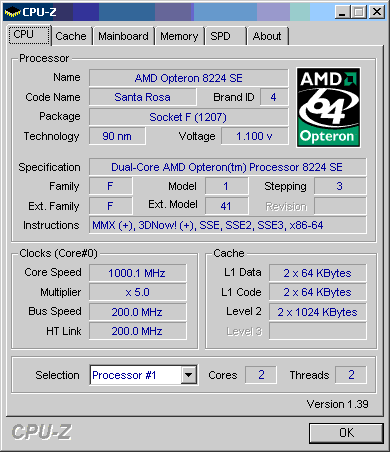A Closer Look at AMD's Newest Offering
AMD thus brings four new CPUs into the server space:

The Opteron 2224 package
To position AMD's new Opteron 2224 offering we take a look at the most interesting Intel and AMD CPUs at the current date.
So basically, AMD's 120W Dual core 3.2GHz Opteron has to prove that it is a worthy competitor to two Intel offerings:
This means that the software only has to make use of two CPU cores (eight cores needs four instances), which is a lot easier than making use of all eight cores in a single instance. This kind of "multi instance" benchmarking may reflect the way quite a few people and businesses use their servers, but at the same time such benchmarks can paint a picture that is far too optimistic for those people who are only running one application on their server.
Secondly, it might seem like a dual Opteron 2224 needs 80W more, but the reality is different. Intel's Northbridge consumes up to 20W more, and each FB-DIMM needs about 5W more than the DDR modules the AMD platform uses. So the difference is not as big as it might seem at first, something we have shown in a previous article. The AMD CPUs also scale back to 1GHz when running at idle, while the Intel CPUs run at 1.6 or 2GHz when idle. As a result the AMD platforms can consume less power when idle or at lower loads.

The Opteron runs now at 3.2GHz
As you can see in the animated gif above, the CPU is capable of scaling back to 1GHz and 1.1V. It can also run at 2.8GHz at 1.275V, and it needs 1.375V to run at 3.2GHz. PowerNow! enables it to run at any frequency between 1.6GHz to 2.8GHz in steps of 200MHz. Keep this in mind when we look at some power figures later on.
AMD thus brings four new CPUs into the server space:
- A 3.2GHz Opteron which consumes at most 120W, in dual and quad/octal socket versions
- A 3GHz Opteron 8222 and 2222 which used to consume up to 120W, but which are - thanks to process improvements - now limited to 95W

The Opteron 2224 package
To position AMD's new Opteron 2224 offering we take a look at the most interesting Intel and AMD CPUs at the current date.
| Intel Processor Overview | ||||||||
| Intel CPU | Clock | Codename | L2 | L3 | FSB | Mem bandwidth | TDP | Price |
| Dual NetBurst CPUs | ||||||||
| Xeon MP 7140M | 3.4GHz | Tulsa | 2x1MB | 16MB | 200MHz Quad | 6.4 GB/s | 150W | $1,980 |
| Xeon MP 7130M | 3.2GHz | Tulsa | 2x1MB | 8MB | 200MHz Quad | 6.4 GB/s | 150W | $1,391 |
| Xeon MP 7120M | 3GHz | Tulsa | 2x1MB | 4MB | 200MHz Quad | 6.4 GB/s | 95W | $1,117 |
| Quad Core CPUs | ||||||||
| Xeon E5355 | 2.66GHz | Clovertown | 2x4MB | - | 333MHz Quad | 21 GB/s | 120W | $1,172 |
| Xeon E5345 | 2.33GHz | Clovertown | 2x4MB | - | 333MHz Quad | 21 GB/s | 80W | $851 |
| Xeon E5320 | 1.86GHz | Clovertown | 2x4MB | - | 266MHz Quad | 17 GB/s | 80W | $690 |
| Dual Core CPUs | ||||||||
| Xeon DP 5160 | 3GHz | Woodcrest | 4MB | - | 333MHz Quad | 21 GB/s | 80W | $851 |
| Xeon DP 5150 | 2.66GHz | Woodcrest | 4MB | - | 333MHz Quad | 21 GB/s | 65W | $690 |
| Xeon DP 5148 | 2.33GHz | Woodcrest | 4MB | - | 333MHz Quad | 21 GB/s | 40W | $519 |
| AMD Processor Overview | ||||||||
| AMD CPU | Clock | Codename | L2 | L3 | HT | Mem bandwidth | TDP | Price |
| Eight-Way CPUs | ||||||||
| Opteron 8224 SE | 3.2GHz | Santa Rosa | 2x1MB | - | 1000MHz DDR | 10.6 GB/s | 119W | $2,149 |
| Opteron 8222 | 3GHz | Santa Rosa | 2x1MB | - | 1000MHz DDR | 10.6 GB/s | 95W | $1,514 |
| Opteron 8220 | 2.8GHz | Santa Rosa | 2x1MB | - | 1000MHz DDR | 10.6 GB/s | 95W | $1,165 |
| Opteron 8218 | 2.6GHz | Santa Rosa | 2x1MB | - | 1000MHz DDR | 10.6 GB/s | 95W | $873 |
| Opteron 8218 HE | 2.6GHz | Santa Rosa | 2x1MB | - | 1000MHz DDR | 10.6 GB/s | 68W | $1,019 |
| Two-Way CPUs | ||||||||
| Opteron 2224 SE | 3.2GHz | Santa Rosa | 2x1MB | - | 1000MHz DDR | 10.6 GB/s | 119W | $873 |
| Opteron 2222 | 3GHz | Santa Rosa | 2x1MB | - | 1000MHz DDR | 10.6 GB/s | 95W | $698 |
| Opteron 2220 | 2.8GHz | Santa Rosa | 2x1MB | - | 1000MHz DDR | 10.6 GB/s | 95W | $523 |
| Opteron 2218 | 2.6GHz | Santa Rosa | 2x1MB | - | 1000MHz DDR | 10.6 GB/s | 95W | $377 |
| Opteron 2218 HE | 2.6GHz | Santa Rosa | 2x1MB | - | 1000MHz DDR | 10.6 GB/s | 68W | $450 |
So basically, AMD's 120W Dual core 3.2GHz Opteron has to prove that it is a worthy competitor to two Intel offerings:
- The dual core Xeon 5160 3GHz with a TDP of 80W
- The quad core Xeon 5345 2.33 with a TDP of 80W
This means that the software only has to make use of two CPU cores (eight cores needs four instances), which is a lot easier than making use of all eight cores in a single instance. This kind of "multi instance" benchmarking may reflect the way quite a few people and businesses use their servers, but at the same time such benchmarks can paint a picture that is far too optimistic for those people who are only running one application on their server.
Secondly, it might seem like a dual Opteron 2224 needs 80W more, but the reality is different. Intel's Northbridge consumes up to 20W more, and each FB-DIMM needs about 5W more than the DDR modules the AMD platform uses. So the difference is not as big as it might seem at first, something we have shown in a previous article. The AMD CPUs also scale back to 1GHz when running at idle, while the Intel CPUs run at 1.6 or 2GHz when idle. As a result the AMD platforms can consume less power when idle or at lower loads.

The Opteron runs now at 3.2GHz
As you can see in the animated gif above, the CPU is capable of scaling back to 1GHz and 1.1V. It can also run at 2.8GHz at 1.275V, and it needs 1.375V to run at 3.2GHz. PowerNow! enables it to run at any frequency between 1.6GHz to 2.8GHz in steps of 200MHz. Keep this in mind when we look at some power figures later on.










30 Comments
View All Comments
2ManyOptions - Monday, August 6, 2007 - link
... for most of the benchmarks Intel chips performed better than the Opterons, don't know why Intel should get scared from these, they can safely wait for Barcelona. Didn't really understand why you have out it as AMD is still in game with these in the 4S space.baby5121926 - Monday, August 6, 2007 - link
intel got scared because they dont want to see the real result from AMD + ATI.the longer intel lets AMD lives, the more dangerous intel will be.
that's why you guys can see Intel is attacking AMD really really hard at this meantime... just to kick AMD out of the game.
Justin Case - Monday, August 6, 2007 - link
What are the units in the WinRAR results table?coldpower27 - Monday, August 6, 2007 - link
Check Intel own pricing lists, and you will see that Intel has already pre-empted some of these cuts with their Xeon X5355 at $744 or Xeon E5345 at $455 and the "official" Xeon X5365 should be cout soon if not already...http://www.intel.com/intel/finance/pricelist/proce...">http://www.intel.com/intel/finance/pric...rice_lis...
TheOtherRizzo - Monday, August 6, 2007 - link
I know nothing about 4S servers. But what's the essence of this article? Surely not that NetBurst is crap? We've known that for years. Is the real story here that Intel doesn't really give a s*** about 4S, otherwise they would have moved on to the core 2 architecture long ago? Just guessing.coldpower27 - Monday, August 6, 2007 - link
Xeon 7300 Series based on the Tigerton core which is a 4 Socket Capable Kentsfield/Clovertown derivatives is arriving in Sepetember this year, so Intel does care in becoming more competitive in the 4S space, but it is just taking some time.They decided to concentrate on the high volume 2S sector is all first, since Intel has massive capacity, going for the high volume sector first makes sense.
mino - Monday, August 13, 2007 - link
Yes and no, actually to have two intel quads running on a single FSB was a serious technical problem.Therefore they had to wait for 4-FSB chipset to be able to get them out the door. Not to mention the qualification times which are a bit onger for 4S platforms that 2S.
AMD does not have these obstacles as 8xxx series are essentially 2xxx series from stability/reliability POW.
Calin - Monday, August 6, 2007 - link
The 5160 processor is Core2 unit, not a NetBurst one. Also, the 5345 is a quad core based on Core2jay401 - Monday, August 6, 2007 - link
People built 3.0GHz - 3.33GHz E4300 & E4400 systems six months ago that cost roughly $135 for the CPU. Others went for an E6300 or more recently an E6320, both again under $200.They were all relatively easy overclocks.
Why does anyone with any skill in building their own computer care about an $800+ CPU again?
Calin - Monday, August 6, 2007 - link
Why don't Ford Mustangs use a small engine, overclocked to hell? Like an inline 4 2.0l with turbo, and a high rpm instead of their huge 4+ liter engines?Why do trucks use those big engines, when they could get the same power from a smaller, gasoline, turbocharged engine?
People pay $800+ for processors that work in multiprocessor systems (your run of the mill Athlon64 or E4300 won't run). Also, they use error checking (and usually error correcting) memory in their systems - again, Athlon64 doesn't do this. They also use registered DDR in order to access more memory banks - your Athlon64 again falls short. On the E4300 side, the chipset is responsible with those things, so you could use such a processor in a server chassis - if the socket fits.